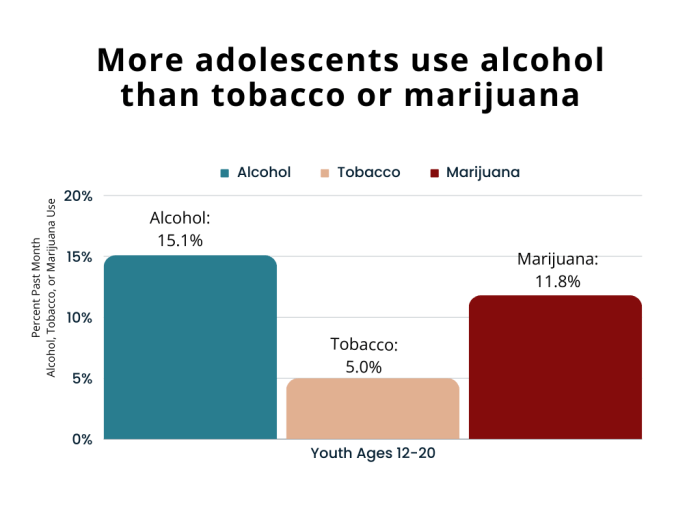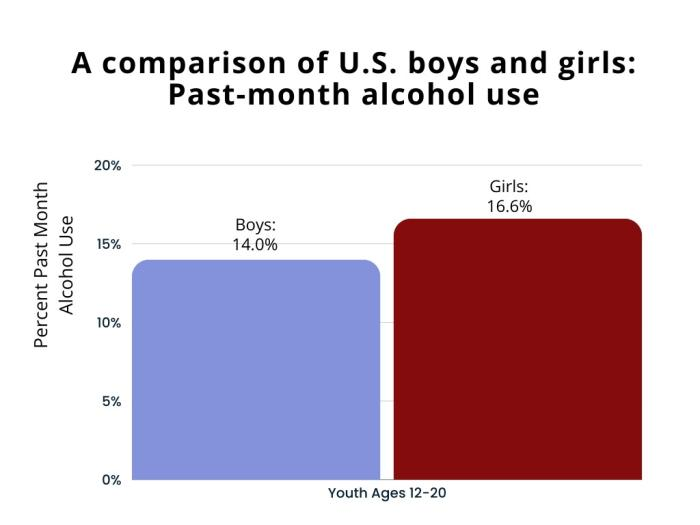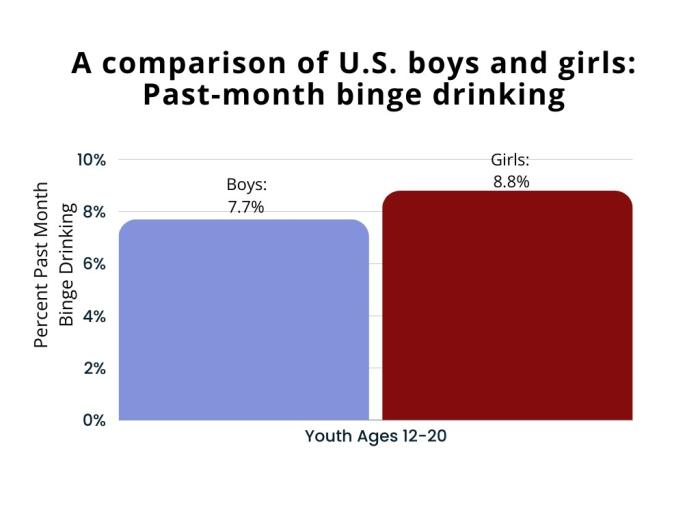Get the Facts About Underage Drinking (NIAAA)
Website: https://www.niaaa.nih.gov/publications/brochures-and-fact-sheets/underage-drinking
Underage drinking is a serious public health problem in the United States. Alcohol is the most widely used substance among America’s youth and can cause them enormous health and safety risks.
The consequences of underage drinking can affect everyone—regardless of age or drinking status.
Either directly or indirectly, we all feel the effects of the aggressive behavior, property damage, injuries, violence, and deaths that can result from underage drinking. This is not simply a problem for some families—it is a nationwide concern.
Underage Drinking Statistics
Many Youth Drink Alcohol
-
In 2022, according to the National Survey on Drug Use and Health (NSDUH), about 19.7% of youth ages 14 to 15 reported having at least 1 drink in their lifetime.
-
In 2022, 5.8 million youth ages 12 to 20 reported drinking alcohol beyond “just a few sips” in the past month.
-
Adolescent alcohol use differs by race and ethnicity. For example, at age 14, White, Black, and Hispanic youth are equally likely to drink. By age 18, White and Hispanic youth are twice as likely to drink than Black youth.
How Much Is a Drink?In the United States, a standard drink is defined as any beverage containing 0.6 fluid ounces or 14 grams of pure alcohol (also known as an alcoholic drink equivalent), which is found in:
The percentage of pure alcohol, expressed here as alcohol by volume (alc/vol), varies within and across beverage types. Although the standard drink amounts are helpful for following health guidelines, they may not reflect customary serving sizes. A large cup of beer, an overpoured glass of wine, or a single mixed drink could contain much more alcohol than a standard drink. |
Youth Often Binge Drink
People ages 12 to 20 drink 3.2% of all alcohol consumed in the United States. Although youth drink less often than adults, when they do drink, they drink more. Approximately 90% of all beverages containing alcohol consumed by youth are consumed by youth who engage in binge drinking (see the "What Is Binge Drinking?" box).
-
In 2022, 3.2 million youth ages 12 to 20 reported binge drinking at least once in the past month.2
-
In 2022, approximately 646,000 youth ages 12 to 20 reported binge drinking on 5 or more days over the past month.

SOURCE: 2022 National Survey on Drug Use and Health. Tables 2.9B, 2.3B, 1.7B. Accessed December 12, 2023.
Drinking Patterns Vary by Age and Gender
Alcohol use often begins during adolescence and becomes more likely as adolescents age. In 2022, fewer than 2 in 100 adolescents ages 12 to 13 reported drinking alcohol in the past month, and fewer than 1 in 100 engaged in binge drinking.5 Among respondents ages 16 to 17, fewer than 1 in 5 reported drinking, and fewer than 1 in 10 reported binge drinking.5 Implementing prevention strategies during early adolescence is needed to prevent this escalation, particularly because earlier alcohol use is associated with a higher likelihood of a variety of alcohol-related consequences.
Historically, adolescent boys were more likely to drink and binge drink than girls. Now, that relationship has reversed. Past-month alcohol use among adolescents ages 12 to 17 has declined more in recent years for boys than girls, with more girls reporting more alcohol use (8.5% vs. 5.5%) and binge drinking (4.0% vs. 2.6%) than boys.

SOURCE: Past-month alcohol use: consuming a drink of a beverage containing alcohol (a can or bottle of beer, a glass of wine or a wine cooler, a shot of distilled spirits, or a mixed drink with distilled spirits in it), not counting a sip or two from a drink in the past 30 days. Population prevalence estimates (%) are weighted by the person-level analysis weight and derived from the Center for Behavioral Health Statistics and Quality (CBHSQ) 2022 National Survey on Drug Use and Health (NSDUH-2022-DS0001) public-use file. [cited 2024 Jan 12]. Available from: https://www.datafiles.samhsa.gov/dataset/national-survey-drug-use-and-health-2022-nsduh-2022-ds0001

SOURCE: Past-month binge drinking: consuming five or more drinks on the same occasion for males or four or more drinks on the same occasion for females on at least 1 day in the past 30 days. Population prevalence estimates (%) are weighted by the person-level analysis weight and derived from the Center for Behavioral Health Statistics and Quality (CBHSQ) 2022 National Survey on Drug Use and Health (NSDUH-2022-DS0001) public-use file. [cited 2024 Jan 12]. Available from: https://www.datafiles.samhsa.gov/dataset/national-survey-drug-use-and-health-2022-nsduh-2022-ds0001
Underage Drinking is Dangerous
Underage drinking poses a range of risks and negative consequences. It is dangerous because it:
- Causes many deaths. Alcohol is a significant factor in the deaths of people younger than age 21 in the United States each year. This includes deaths from motor vehicle crashes, homicides, alcohol overdoses, falls, burns, drowning, and suicides.
- Causes many injuries. Drinking alcohol can cause youth to have accidents and get hurt. In 2011 alone, about 188,000 people younger than age 21 visited an emergency room for alcohol-related injuries.
- Impairs judgment. Drinking can lead to poor decisions about taking risks, including unsafe sexual behavior, drinking and driving, and aggressive or violent behavior.
- Increases the risk of physical and sexual assault. Underage binge drinking is associated with an increased likelihood of being the victim or perpetrator of interpersonal violence.
- Can lead to other problems. Drinking may cause youth to have trouble in school or with the law. Drinking alcohol is also associated with the use of other substances.
- Increases the risk of alcohol problems later in life. Research shows that people who start drinking before the age of 15 are at a higher risk for developing alcohol use disorder (AUD) later in life. For example, adults ages 26 and older who began drinking before age 15 are 3.5 times more likely to report having AUD in the past year than those who waited until age 21 or later to begin drinking.
- Interferes with brain development. Research shows that people’s brains keep developing well into their 20s. Alcohol can alter this development, potentially affecting both brain structure and function. This may cause cognitive or learning problems as well as may increase vulnerability for AUD, especially when people start drinking at a young age and drink heavily.
Why Do So Many Youth Drink?
As children mature, it is natural for them to assert their independence, seek new challenges, and engage in risky behavior. Underage drinking is one such behavior that attracts many adolescents. They may want to try alcohol but often do not fully recognize its effects on their health and behavior. Other reasons youth drink alcohol include:
-
Peer pressure
-
Increased independence or the desire for it
-
Stress
In addition, many youth have easy access to alcohol. In 2022, among adolescents ages 12 to 14 who reported drinking alcohol in the past month, 97.7% reported getting it for free the last time they drank. In many cases, adolescents have access to alcohol through family members or find it at home.
What Is Binge Drinking?The National Institute on Alcohol Abuse and Alcoholism (NIAAA) defines binge drinking as a pattern of drinking that brings blood alcohol concentration (BAC) to 0.08%—or 0.08 grams of alcohol per deciliter—or more.* This typically happens if a woman has 4 or more drinks, or a man has 5 or more drinks, within about 2 hours. Research shows that fewer drinks in the same timeframe result in the same BAC in youth: only 3 drinks for girls, and 3 to 5 drinks for boys, depending on their age and size.
|
Preventing Underage Drinking
Preventing underage drinking is a complex challenge. Any successful approach must consider many factors, including:
-
Genetics
-
Personality
-
Rate of maturation and development
-
Level of risk
-
Social factors
-
Environmental factors
Several key approaches have been found to be successful. They are:
- Individual-level interventions. This approach seeks to change the way youth think about alcohol so they are better able to resist pressures to drink.
- School-based interventions. These are programs that provide students with the knowledge, skills, motivation, and opportunities they need to remain alcohol-free.
- Family-based interventions. These are efforts to empower parents to set and enforce clear rules against drinking, as well as improve communication between children and parents about alcohol.
- Community-based interventions. Community-based interventions are often coordinated by local coalitions working to mitigate risk factors for alcohol misuse.
- Policy-level interventions. This approach makes alcohol harder to get—for example, by raising the price of alcohol and keeping the U.S. Minimum Legal Drinking Age at 21. Enacting zero-tolerance laws that outlaw driving after any amount of drinking for people younger than 21 can also help prevent problems.
The Role Parents Play
Parents and teachers can play a meaningful role in shaping youth’s attitudes toward drinking. Parents, in particular, can have either a positive or negative influence.
Parents can help their children avoid alcohol problems by:
-
Talking about the dangers of drinking
-
Drinking responsibly if they choose to drink
-
Serving as positive role models in general
-
Not making alcohol available
-
Getting to know their children’s friends
-
Having regular conversations about life in general
-
Connecting with other parents about sending clear messages about the importance of youth not drinking alcohol
-
Supervising all parties to make sure there is no alcohol
-
Encouraging kids to participate in healthy and fun activities that do not involve alcohol
Research shows that children of actively involved parents are less likely to drink alcohol. However, if parents provide alcohol to their kids (even small amounts), have positive attitudes about drinking, and engage in alcohol misuse, adolescents have an increased risk of misusing alcohol. Moreover, if the adolescent has a parent with AUD, they are less likely to be protected from alcohol misuse through parental engagement and other factors.
Warning Signs of Underage Drinking
Adolescence is a time of change and growth, including behavior changes. These changes usually are a normal part of growing up but sometimes can point to an alcohol problem. Parents, families, and teachers should pay close attention to the following warning signs that may indicate underage drinking:
-
Changes in mood, including anger and irritability
-
Academic or behavioral problems in school
-
Rebelliousness
-
Changing groups of friends
-
Low energy level
-
Less interest in activities or care in appearance
-
Finding alcohol among an adolescent's belongings
-
Smelling alcohol on an adolescent's breath
-
Problems concentrating or remembering
-
Slurred speech
-
Coordination problems
Treating Underage Drinking Problems
Screening youth for alcohol use and AUD is very important and may prevent problems down the road. Screening by a primary care provider or other health practitioner (e.g., pediatrician) provides an opportunity to identify problems early and address them before they escalate. It also allows adolescents to ask questions of a knowledgeable adult. NIAAA and the American Academy of Pediatrics both recommend that all youth be regularly screened for alcohol use.
Some youth can experience serious problems as a result of drinking, including AUD, which require intervention by trained professionals. Professional treatment options include:
- Attending individual or group counseling sessions one or more times per week
- Receiving a prescription from a primary care provider or psychiatrist to help reduce alcohol cravings
- Participating in family therapy to build a supportive foundation for recovery
For more information, please visit: niaaa.nih.gov
